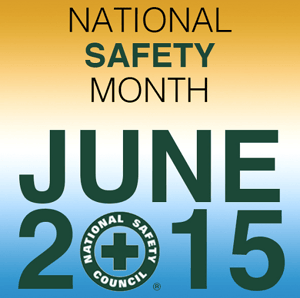June is National Safety Month
Anneliese Peterson | Jun 26, 2015
June is National Safety Month in the United States. This occasion, sponsored by the National Safety Council in conjunction with hundreds of organizations around the U.S., seeks to heighten awareness of the leading causes of injuries in everyday life.
What is National Safety Month?
During National Safety Month, you'll see public service announcements, online ads, and posters, all stressing the importance of putting safety practices in place to avoid things like slips and falls, misuse of prescription medications, and burns.
Preventing injury is important, and we want to help you stay safe!
Simple Safety Tips
Staying safe in your living space doesn't have to be expensive or complicated. There are many small changes you can make to help avoid potential mishaps. Below are just a few examples to get you thinking about safety…
 1. Rethink the Throw Rugs: Small rugs can help your room look more colorful, but unanchored throw rugs can also be a hazard. It is best to opt for larger area rugs that are anchored by furniture pieces or forgo the rugs altogether.
1. Rethink the Throw Rugs: Small rugs can help your room look more colorful, but unanchored throw rugs can also be a hazard. It is best to opt for larger area rugs that are anchored by furniture pieces or forgo the rugs altogether.
2. Clean Out Your Medicine Cabinet Twice a Year: Reaching for the wrong prescription or taking an outdated medication can also be a hazard. It is wise to keep your medications secured and clean out any unused bottles twice a year. For safe disposal, take them to a local pill collection site.
3. Maintain Adequate Lighting: Burnt out light bulbs and dim lighting can make it more difficult to see obstacles. Avoid this by keeping a supply of light bulbs on hand and making sure that each stairway and hallway is sufficiently lit.
Helping Yourself and Others Stay Safe in an Emergency
Unfortunately, no part of the country is safe from emergencies. While we don't have to worry about hurricanes here in Minnesota, a fire or a power outage can disrupt our daily routine and cause many of the services and utilities that we count on to be unavailable. To be prepared for an emergency, every household should have an emergency kit. Just a few of the things you should pack in this kit include:
- Food for at least three days: Include non-perishable dried or canned foods, enough to use for at least three days. (Don't forget your pets, too.) Pack a manual can opener and bottle opener.
- Water: Water is perhaps the most important component of your emergency kit. Make sure that you have a gallon per person plus extra for pets. You'll also want to switch out the water every three to six months to make sure that it's fresh when you need it.
- Hand-crank radio and phone charger: A hand-crank radio and other devices use your physical energy to re-charge the batteries, keeping communication lines open. Be sure to include extra batteries.
- A basic first-aid kit: A first aid kit is also important. Make sure yours has bandages, gauze, an anti-bacterial agent, scissors, and aspirin or other anti-inflammatory medications.
- Whistles: Have whistles in your kit so you can have one to blow in case you need to alert rescuers of your location.
This is only a partial list. A complete emergency check list can be found on the American Red Cross website.
Keeping yourself and others safe doesn't have to be difficult or costly. It does, however, require just a little thought, time and preparedness. Talk with family or friends and discuss the little changes you can make to maintain your safety.

